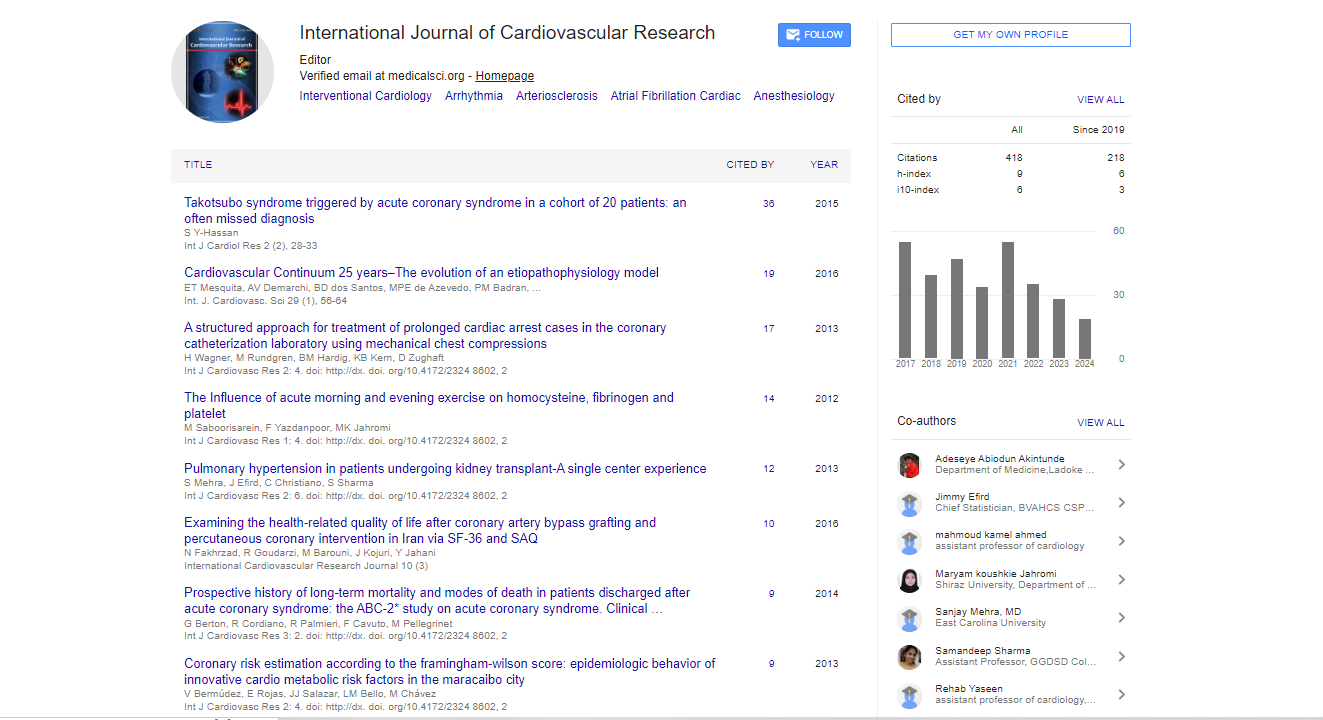Commentary, Int J Cardiol Res Vol: 13 Issue: 5
Polypills for Hypertension: A Promising Approach to Simplifying Treatment and Improving Adherence
Priya Sharma*
1Department of Cardiovascular Medicine, Cleveland Clinic Lerner College of Medicine, Cleveland, United States of America
*Corresponding Author: Priya Sharma,
Department of Cardiovascular Medicine,
Cleveland Clinic Lerner College of Medicine, Cleveland, United States of America
E-mail: priya.sharma@eduinstitute.com
Received date: 23 September, 2024 Manuscript No. ICRJ-24-153190;
Editor assigned date: 25 September, 2024, PreQC No. ICRJ-24-153190 (PQ);
Reviewed date: 09 October, 2024, QC No. ICRJ-24-153190;
Revised date: 16 October, 2024, Manuscript No. ICRJ-24-153190 (R);
Published date: 23 October, 2024, DOI: 10.4172/2324-8602.1000583.
Citation: Sharma P (2024) Polypills for Hypertension: Approach to Simplifying Treatment and Improving Adherence. Int J Cardiol Res 13:5.
Description
Hypertension, or high blood pressure, is a widespread and multifactorial condition that affects millions of people worldwide. As a major risk factor for Cardiovascular Diseases (CVD), including heart attack, stroke and heart failure, hypertension poses a significant public health challenge. While numerous antihypertensive medications are available, many patients struggle with treatment adherence due to complex medication regimens, side effects and the chronic nature of the disease. To address these issues, the concept of the "polypill" has emerged as a promising solution for simplifying hypertension treatment.
A polypill is a combination medication that contains multiple Active Pharmaceutical Ingredients (APIs) in a single pill or tablet. Typically, these medications include drugs from different classes that target various mechanisms involved in the disease. In the context of hypertension, a polypill for high blood pressure usually combines several antihypertensive agents, such as a diuretic, an Angiotensin- Converting Enzyme (ACE) inhibitor, a calcium channel blocker and a beta-blocker. The goal of a polypill is to simplify the treatment regimen for patients by reducing the number of pills they need to take daily, thereby improving adherence and optimizing therapeutic outcomes. Hypertension is often a complex condition with multiple contributing factors, including excessive sodium intake, genetic predisposition, obesity and a sedentary lifestyle. Polypills aim to address these factors by combining drugs that target different pathways involved in regulating blood pressure. By combining drugs that work synergistically, polypills may enhance efficacy while reducing the likelihood of adverse effects associated with higher doses of single-agent therapies.
The primary explanation for developing and promoting polypills for hypertension lies in the issue of medication adherence. Hypertension is a chronic condition that requires long-term management, often with a combination of drugs to achieve optimal control. However, studies have shown that many patients do not adhere to their prescribed treatment regimens, which can lead to poor blood pressure control, increased risk of cardiovascular events and a greater burden on healthcare systems. The reasons for poor adherence are multifactorial. The complexity of treatment regimens, particularly for patients who require multiple medications, can be immense. Taking several pills daily may be difficult and lead to "pill fatigue," where patients may forget to take their medications or stop taking them altogether. In addition, side effects from multiple drugs can discourage patients from continuing their treatment. Polypills aim to simplify treatment by combining multiple antihypertensive agents into a single pill, reducing the pill burden and improving the likelihood of adherence. The simplicity of taking one pill daily, rather than several, can enhance patient compliance and ensure more consistent blood pressure control. Furthermore, by offering a combination of drugs that work on different mechanisms, polypills may provide more effective and comprehensive management of hypertension.
A typical polypill for hypertension is a fixed dose combination that includes medications from different classes, each targeting a specific aspect of blood pressure regulation. Diuretics, such as hydrochlorothiazide, are often included in polypills for hypertension. These medications help to reduce fluid volume in the body, thereby lowering blood pressure by decreasing the amount of blood flowing through the arteries. Angiotensin-Converting Enzyme (ACE) inhibitors such as enalapril or lisinopril, block the enzyme responsible for converting angiotensin I into angiotensin II. Angiotensin II is a potent vasoconstrictor, so inhibiting its production helps to relax blood vessels and reduce blood pressure. Calcium channel blockers, such as amlodipine, inhibit the influx of calcium into the smooth muscle cells of blood vessels. This action leads to vasodilation, which lowers blood pressure by relaxing the arterial walls. Beta-blockers, such as atenolol or metoprolol, work by blocking the beta-adrenergic receptors in the heart. This reduces the heart rate and the force of contraction, which in turn lowers blood pressure. In addition to these common classes of drugs, some polypills may also include other antihypertensive agents, such as Angiotensin II Receptor Blockers (ARBs) or aldosterone antagonists. The exact combination of drugs in a polypill may vary depending on the specific needs of the patient and the treatment goals.
Conclusion
Polypills for hypertension provides approach to simplifying treatment, improving patient adherence and enhancing blood pressure control. By combining multiple antihypertensive agents into a single pill, polypills reduce the pill burden, lower healthcare costs and provide a more comprehensive strategy for managing hypertension. While challenges exist, including the need for individualized treatment and the potential for overmedication, the advantages of polypills make them an important tool in the fight against hypertension. As further study and clinical trials continue to explore their efficacy and safety, polypills may play an important role in improving hypertension management and reducing the global burden of cardiovascular diseases.
 Spanish
Spanish  Chinese
Chinese  Russian
Russian  German
German  French
French  Japanese
Japanese  Portuguese
Portuguese  Hindi
Hindi 



